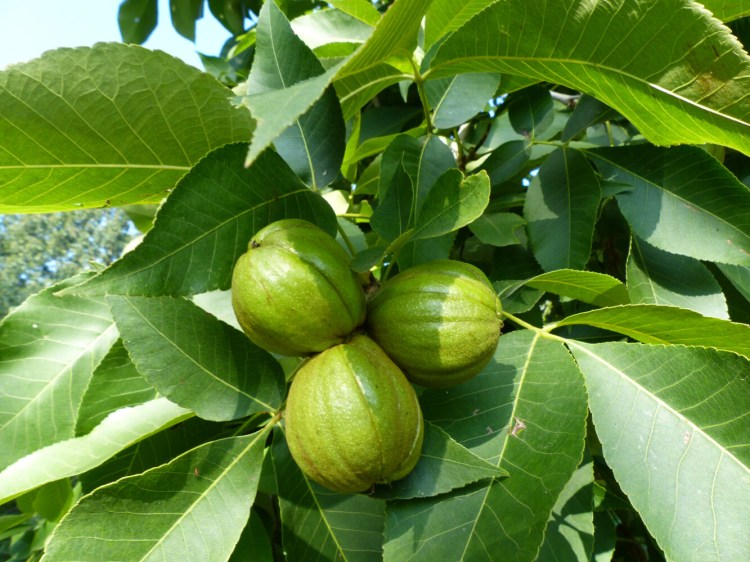People did a lot more landscaping of their properties last year than in an ordinary year. They also grew more food.
One option combines the two activities. Andy Brand, curator of living collections at Coastal Maine Botanical Gardens, outlined ways to landscape with wild edibles in an online lecture in late January.
Growing edibles has several advantages, only one of which is the production of good things to eat. Many of the plants, which range from low-growing ground covers to tall trees, also look attractive in the garden and provide food and habitat for desirable wildlife.
Brand opened the lecture, part of the Green Spotlight Series co-sponsored by Coastal Maine Botanical Gardens and the Maine Landscape and Nursery Association, with a picture showing his then-young nephew gobbling down aronia berries from a bush. Aronia is a native superfood, high in antioxidants. To most people, it is too bitter to eat fresh – but clearly that’s not the case for everyone. With white flowers, red or black fruit and brilliant fall foliage, aronia also makes a good landscape plant. The bushes grow in full shade to sun, so are good shrubs for almost anywhere you’d like to plant them. The bushes can form a thicket. Once they do so, the oldest stems should be removed after fruiting each year.
Figuring his audience already knew about them, Brand touched only briefly on common natives typically grown for fruit, such as blueberries, cranberries, raspberries and blackberries, focusing instead on less-common edibles.
He likes amelanchier, which has fleeting white flowers that are a good nectar source for bees in early spring, as well as quite tasty berries for humans, he said. My wife Nancy and I leave ours for the wildlife. Amelanchier like high-canopy shade. One downside: the bushes/small trees are susceptible to rust disease if any cedars grow nearby.
Brand had high praise for the native black cherry, which supports all kinds of caterpillars and other wildlife. I devoted a column to this tree last summer, after I discovered some on our property. Don’t park a car under the tree when it is in fruit, though, he warned, lest your car be covered in bird droppings.
Elderberry, another fruit known for its health benefits, grows 6 to 7 feet tall, produces white flowers that bees love, and a lot of fruit that both people and birds love. In fact, if you want the berries for yourself, Brand recommended you put a net over the plants to keep the birds away.
He praised native viburnums, especially Viburnum nudum, or the wild raisin. We planted some of those a few years ago and have enjoyed the blossoms but haven’t yet seen any fruit. Maybe animals are getting to it first.
Wintergreen, which takes full sun but prefers shadier locations, has a lot of benefits in the garden. An attractive evergreen ground cover, its shiny leaves can be used for tea and the berries eaten straight from the plant.
Not so much the May apple, or Podophyllum. It is an attractive plant, growing about 14 inches tall, with nice white flowers, and is sometimes used as a ground cover. But all parts of the plant are poisonous, including the fruit – at least until it is so ripe that it is almost rotten. Brand showed a picture of what he insisted were tasty, non-poisonous May apples, which looked like regular apples that had been sitting at the bottom of the barrel for too long. We planted some May apple last year, so I will watch it carefully, but we’re not planning on eating the apples.
Sumac is another plant that I wasn’t sure was edible, but Brand said its fruit makes tasty juice known as Rhus juice or Sumacade. It is an aggressive native, that can grow as trees but usually grows as thickets. The fruit is small, and surrounded by small thorn-like prickles that can cause a rash. (You can also dehydrate the fruit and turn it into a spice that’s used in much Middle Eastern cooking, my editor told me.)
A couple of nuts he mentioned are hickories, which can be harvested from the ground, but which grow huge, and hazelnuts. The latter are surrounded by leaves with spines that will scratch your hands, so wear gloves to pick them.
Groundnuts, Apios americana, is an interesting vine that produces two kinds of fruit. It needs support and space and can be aggressive, Brand warned, but it creates both tasty tubers underground and beans above ground. As long as you leave some of the tubers when you harvest, the vine will come back each year.
These are just a few things to think about as we wait for gardening season.
Tom Atwell is a freelance writer gardening in Cape Elizabeth. He can be contacted at: tomatwell@me.com
Send questions/comments to the editors.



Comments are no longer available on this story